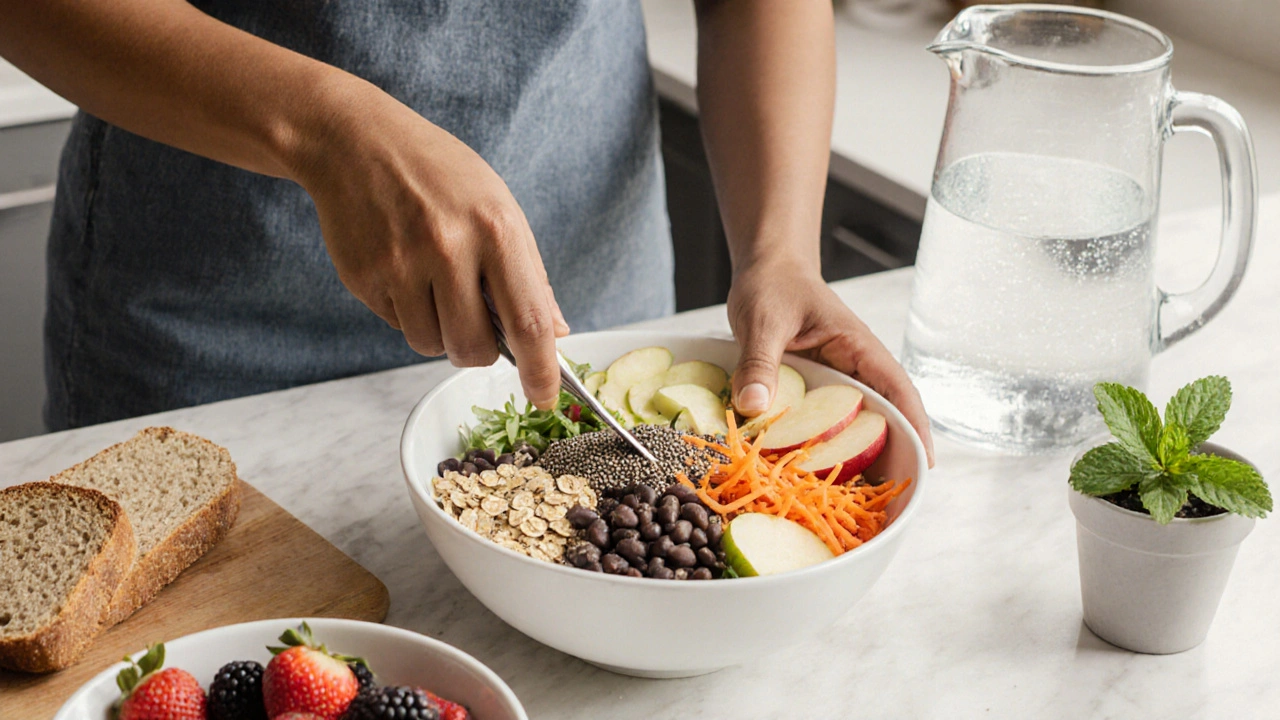

When talking about Fiber, the plant‑based carbohydrate that your body can’t digest but your gut loves. Also known as dietary fiber, it plays a key role in digestion, heart health, and blood sugar regulation. Dietary fiber comes in two main flavors – Soluble fiber and Insoluble fiber – each with its own set of benefits.
Think of soluble fiber as a sponge. It dissolves in water, forms a gel‑like substance, and can trap cholesterol and sugar. This gel slows down absorption, which helps lower LDL cholesterol and smooth out blood‑sugar spikes after meals. Insoluble fiber, on the other hand, adds bulk to stool and speeds up its passage through the colon, keeping you regular and supporting a healthy gut lining. Both types work together to keep your digestive system humming.
Gut health isn’t just about regularity; it’s about feeding the good bacteria that live in your colon. Certain soluble fibers act as prebiotics – they’re food for these microbes, encouraging a balanced microbiome. A thriving microbiome can improve mood, aid immune function, and even help with weight management. Meanwhile, insoluble fiber’s rough texture acts like a brush, sweeping away waste and reducing the risk of diverticulosis. In short, fiber enhances gut health by both feeding beneficial bacteria and keeping the digestive tract clean.
Beyond the gut, fiber influences heart health. The gel formed by soluble fiber binds to bile acids, which contain cholesterol. When the body replaces these bile acids, it pulls cholesterol from the blood, leading to lower overall levels. Studies consistently show that people who consume at least 25‑30 grams of fiber daily have a reduced risk of heart disease. That’s why nutrition guidelines often spotlight soluble fiber sources like oats, beans, and apples.
Blood sugar control is another area where fiber shines. By slowing the digestion of carbohydrates, soluble fiber flattens the post‑meal glucose surge, making it easier for the pancreas to manage insulin release. For anyone watching their blood sugar – whether they have diabetes or simply want steady energy – adding a handful of high‑fiber foods can make a noticeable difference.
Choosing the right sources matters. Soluble fiber shines in foods like oats, barley, peas, lentils, carrots, and citrus fruits. Insoluble fiber is abundant in whole grains, nuts, seeds, and the skins of many fruits and vegetables. A balanced diet that mixes both types ensures you reap all the benefits. If you’re new to high‑fiber eating, ramp up slowly and pair fiber with plenty of water to avoid digestive discomfort.
Our article collection below dives deeper into the science and practical tips around fiber. You’ll find pieces that compare fiber‑rich supplements, explain how fiber interacts with medications, and offer meal‑planning ideas to boost your daily intake. Whether you’re curious about fiber’s role in cholesterol management, looking for gut‑friendly recipes, or need advice on fiber supplements, the posts below cover a wide range of scenarios.
In the next sections, you’ll discover detailed breakdowns of specific fiber types, real‑world advice on integrating fiber into busy lifestyles, and answers to common questions like “Can fiber affect the absorption of my prescription meds?” and “What’s the best time of day to eat fiber‑rich foods?” This curated set aims to give you practical, science‑backed insight so you can make informed choices about your diet today.

Learn how soluble fiber can tame chronic diarrhea, which foods boost the right fiber, which to avoid, and practical tips for a balanced diet.